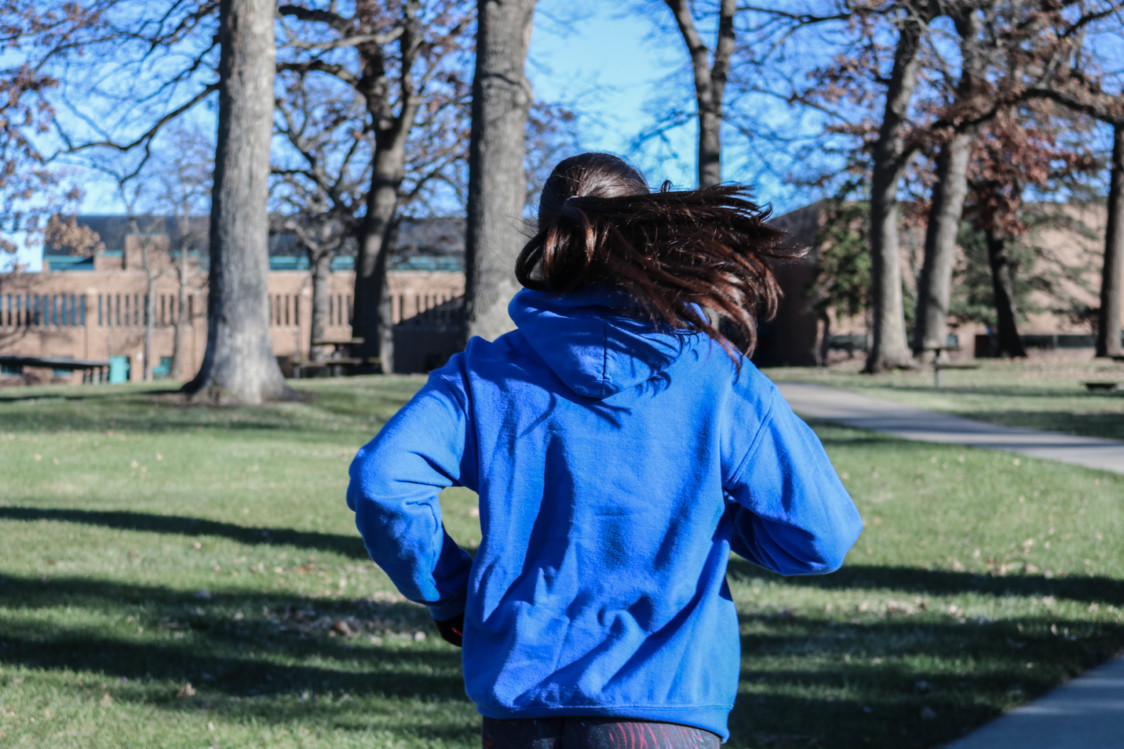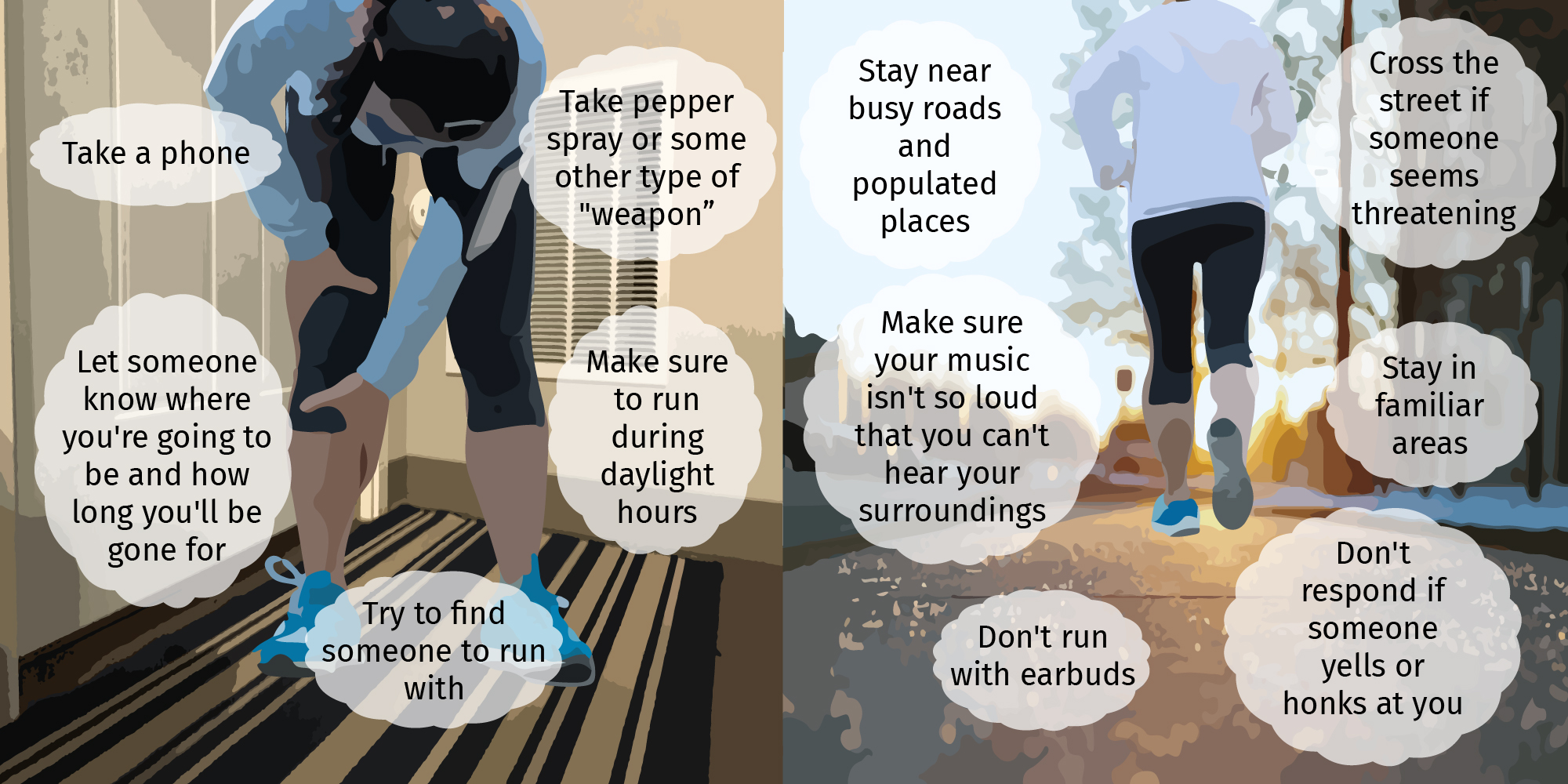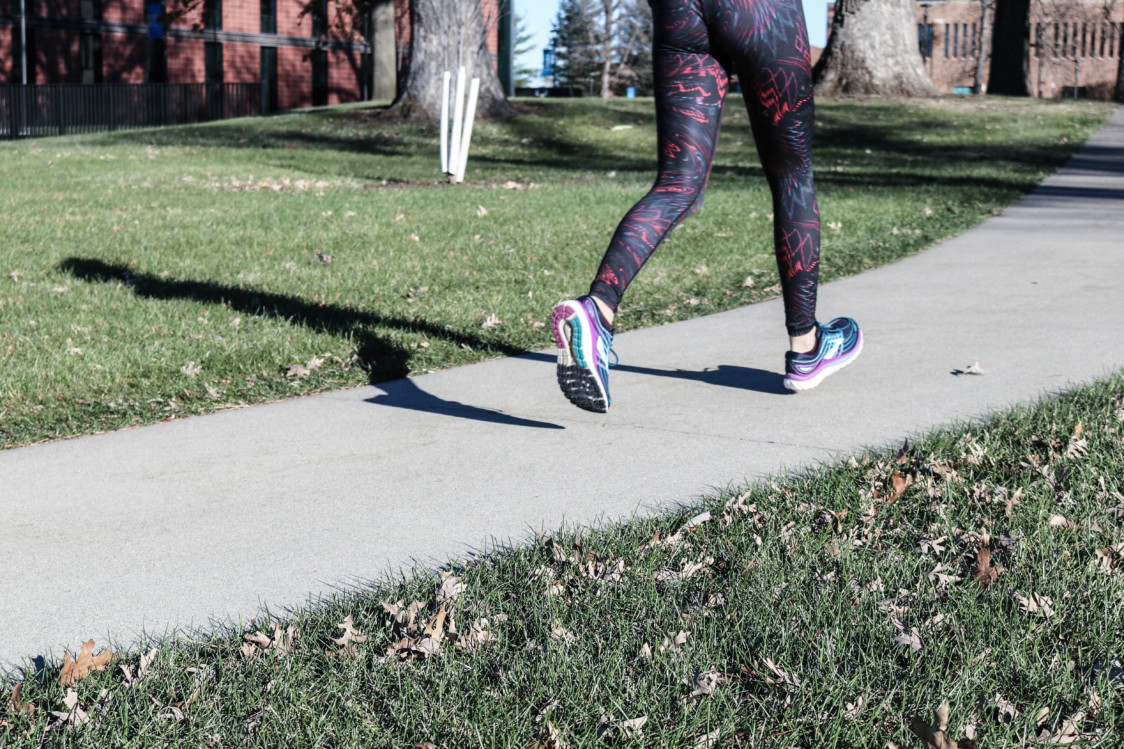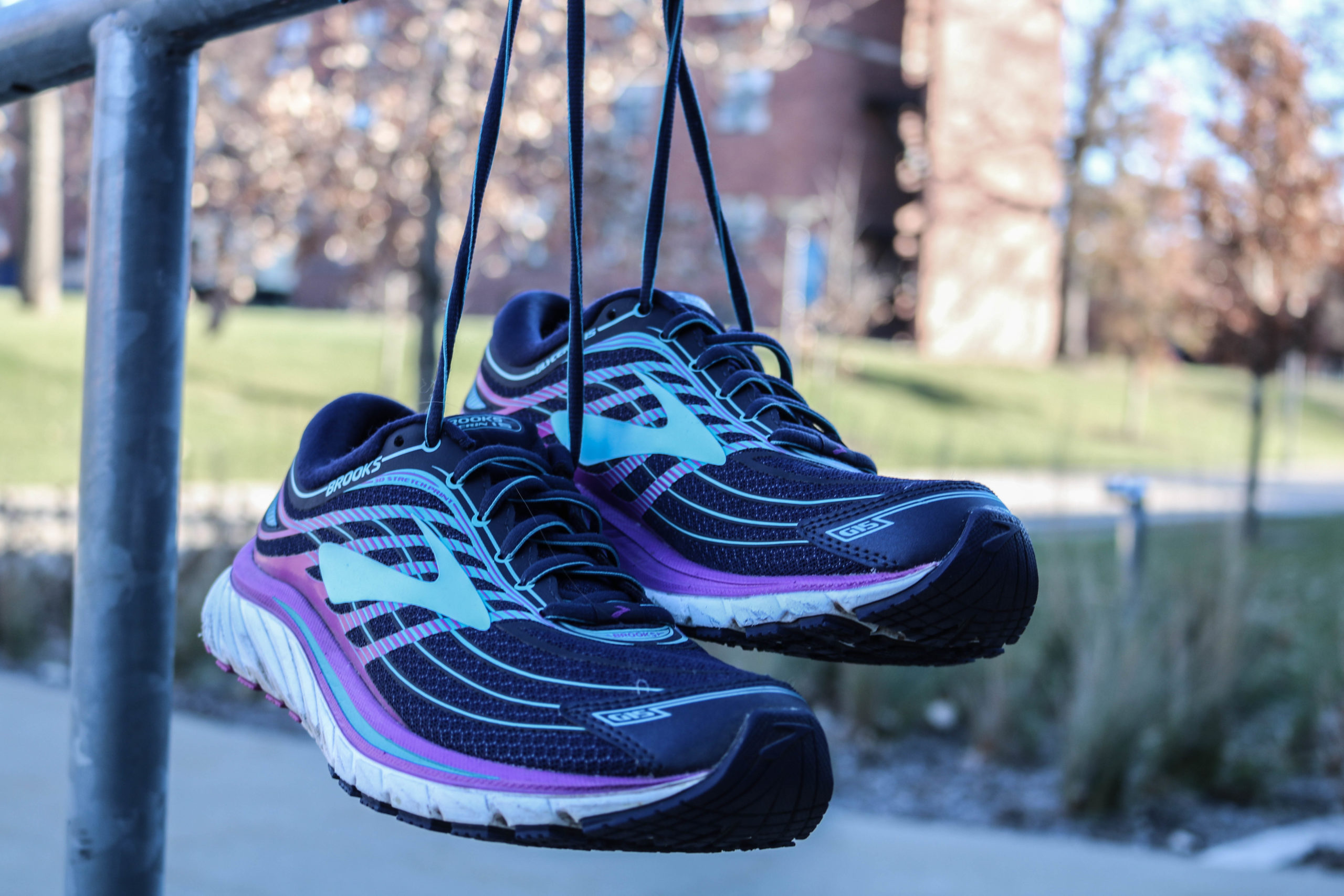Erin Ellefsen, an Indianapolis native and former college track athlete, had just finished up a run at a remote Colorado trail when two men started talking to her. She had come with her boyfriend, but he was still out on the trail, finishing up a run.
At first, they asked about the trail she had just come from, and thinking they were on a road trip, Ellefsen answered their questions. But when she thought the conversation was over, one of the men wouldn’t leave her alone.
“I realized what was going on was not so innocent,” Ellefsen says.
He even went so far as to hug her. Ellefsen didn’t hug back, and the man continued to ask her to accompany him to a music festival, to downtown Boulder, and even asking at one point if she wanted to do drugs. She declined every time, but the man stayed in her personal space.
The other man had disappeared, leaving Ellefsen alone with the stranger. Trying to get away from him, she got into her car. But he climbed into the passenger seat with her.
“I kind of knew when my boyfriend was supposed to be back so I was on the edge of my seat waiting for him to get back, but also knowing that if I was too aggressive and got too angry that it could turn badly quickly,” Ellefsen says. “So I was trying to be calm but also be very like, ‘I don’t want you to be here.’”
She left her car, trying to put any distance she could between her and the stranger. Again, he followed her, sitting next to her until her boyfriend returned.
“I started talking to him, like, trying to give him the signal that something was not okay in this situation,” Ellefsen says. She and her boyfriend both left, and as soon as she got home, she put pepper spray in her glove box.

Ellefsen’s story, while harrowing, isn’t unusual. Many women have stories of strange and frightening encounters while out hitting the pavement or running on a trail. Most know that every time they leave their homes to go for a run, there’s risk involved.
In 2016, Runner’s World asked its readers how often they received “unsolicited sexual attention” while running. Over 40 percent of women—43 percent to be exact—said they sometimes, often, or always experience this kind of behavior, while only 4 percent of men said the same thing.
And creepy experiences, like honking or catcalling, can escalate. In July, college sophomore Mollie Tibbetts went missing after going out for a run in her hometown of Brooklyn, Iowa. Five weeks after she went missing, her body was found in a cornfield. The alleged killer said he followed her in his car, parked, and proceeded to run next to her. Reportedly, Tibbetts told him she would call the police if he didn’t leave her alone. It made her assailant more angry, causing him to apparently “black out,” leading to her death.
In the summer of 2017, three women were murdered during their runs within a span of nine days. They all happened in different areas—in Michigan, Massachusetts, and New York. All three were out during daylight hours.
In that same Runner’s World survey, of the women who said they had concerns about safety or unwanted attention, 73 percent said these concerns encouraged them to run with a phone; 60 percent to run only during daylight hours; 52 percent to change their running route.

Brenna Strawhacker, an avid runner from Des Moines, is no stranger to the honks and yells a female runner can receive. Growing up in a small town, Strawhacker was used to people honking at her while she ran to give her a friendly wave. Now, she feels there’s something more sinister about the honking.
Strawhacker has also been running in a group for the last year or so.
“It’s like I didn’t realize maybe how unsafe I was being until I joined the running group, and now when I have to run alone, I kind of dread it,” Strawhacker says.
It’s been said many times, but it’s true: there’s safety in numbers. And women are starting to turn toward running groups to exercise and still stay safe.
Tracey Weatherly is part of two women’s running groups in Kansas City, 261 Fearless and Kansas City Express. Weatherly says that 261 Fearless gives safety talks at least once a month.
“We only run in a group. We don’t leave anybody behind. We don’t allow ear buds, so that you can hear if somebody comes up behind you, if traffic is coming, that sort of thing,” Weatherly says.
Recently, Fleet Feet, a store for all things running-related, partnered with Des Moines Public Library and Des Moines Police to put on a running safety event for women. Because of the large interest, much of it due to Tibbetts’ recent death, the event was held in the Des Moines Public Library instead of the Fleet Feet store. About 200 women attended.
“I definitely think, more than ever, I get comments from people, when they hear I’m a runner, they hear I’m training for a marathon, they’re like, ‘Oh my gosh, do you run alone?’ That’s everyone’s first question,” Strawhacker says.
No Woman Left Behind
It wasn’t long ago that women couldn’t even run in the Boston Marathon. In 1967, Kathrine Switzer became the first woman to register for and finish the Boston Marathon. She’s probably best known through the iconic black-and-white picture of her running in the race, resisting a man trying to force her out of it.
In the 50 years since, women have slowly taken over the running world. According to Running USA, a non-profit focused on promoting distance running and races, the majority of runners—59 percent of participants—in road races in 2017 were women. Weatherly isn’t surprised by that number.
“I think (running) builds confidence. I think it lets women be genuine,” Weatherly says. “We can be out of … whatever the professional role is. We can be out of the wife role. We can be out of the mom role. Because everybody else kind of knows those roles already.”
Part of that rise can also be attributed to female solidarity. Women-only running groups have sprung up to help women feel safe as they train. The largest: 261 Fearless, the name lifted from the number Switzer was wearing on her race bib in that first Boston Marathon. Now, 261 Fearless is an international organization, spanning from Midwest cities to countries such as Africa, Italy, Austria, and even countries in the Middle East. It’s meant to empower women to run safely and encourage each other to stay healthy and active.
Other running organizations support more marginalized groups. Black Girls Run! is another women-only running group. It started in 2009 to battle growing obesity numbers among African-American women and to encourage all women, especially those of color, to have a healthy lifestyle. Black Girls Run! is all about making sure everyone crosses the finish line.
“I’m personally not a hardcore runner and it’s basically, BGR is more no woman left behind,” says Tammy Williams from the Twin Cities and Saint Paul chapters of Black Girls Run! in Minnesota. “And we’ll make sure that whatever pace you’re going, that we would slow it down.”
The Twin Cities and Saint Paul chapters of Black Girls Run! meet outside of regular runs to encourage each other to stay on track with their fitness goals with fitness vision board parties and other meetups that allows members to get to know each other better.
“You never really get to know the women that you’re running next to, so sometimes it’s nice to just have those events that doesn’t end up with running all the time to get to know, ‘Do you have a family? Are you married? What do you do in your professional life?’ Make those kind of connections,” Williams says.

Exit Strategy
Kristen Strawhacker, Brenna Strawhacker’s cousin-in-law, is like many other women — she has multiple precautions she takes every time she runs. While she regularly runs in a group, she still runs solo. When she does, Kristen tends to run in the morning, when it’s still not fully light out. To stay safe, Kristen wears a light and stays on well-lit roads.
“I work at a women’s health clinic, and a few of us were kind of chatting about this idea of the things women think about that men don’t think about,” Kristen says. “Like the idea of constantly having to know your exit strategy and the idea that someone coming up to you and you don’t know if they’re just saying hi and those kind of things. It’s a different awareness of your vulnerability.”
Ellefsen has always taken precautions when going on a run. In high school, she would dress as much like a man as she could when it still wasn’t light enough in the early mornings. She doesn’t do that anymore. Instead she brings along a cat-shaped self-defense keychain. The “ears” of the cat are sharp enough to do some damage.
“(Safety) has become a very big concern,” Weatherly says. “No run is worth putting yourself at risk. If for some reason you didn’t get your run in, you can get it the next day, or go to a gym and do a treadmill if you really need to, but no run is worth putting your health and your safety at risk.”

